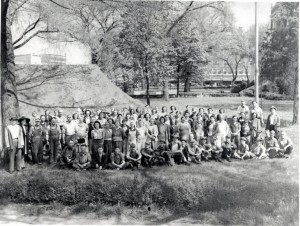
Burks Tent and Awning Co. employees with a World War II Army tent they made and set up on the grounds of the Franklin County Courthouse across the street from the Ottawa, Kansas factory.
from The Headlight, February 2005—Shirley Rudd Dixon, Tent Flap Maker
It was September, 1944, when I arrived in Ottawa, Kansas to attend Ottawa University as a Freshman. We were in the midst of World War II, both in Europe and the Pacific. Transportation from my home in Tribune, Kansas to Ottawa was via the Missouri Pacific “Eagle” as tires and gas were both rationed. Sometimes the “Eagle” had so many passengers we would sit on our luggage—quite a feat as the train swayed along the track. I don’t remember that we were lulled to sleep. The “Eagle” schedule worked well for us; my sister Rube Rudd Pringle, who was a Senior at Ottawa University that year, and I, and occasionally, Joe Smith who would be going to and from Booneville, Missouri where he was attending Kemper Military Academy. We would board the “Eagle” about 10:00 p.m. and arrive in Ottawa about 6:00 a.m.
As you can guess, with so many fellows away in uniform. there weren’t many men on the campus. The girls would be writing to friends or husbands in the service. Rube’s husband, Douglas E. Pringle, was in England at the time. At least two students had lost husbands that summer—one of whom was Elizabeth Dixon Wood who later became my sister-in-law.
Naturally, we created our own entertainment and social life. There would be jaunts downtown to see a movie or have ham salad sandwiches at the Dutch Maid or hamburgers at Miller’s Hamburgers. Mr. Miller closed his shop in a few months as he was having a hard time getting over the loss of his son who had been in the military.
That’s the way it was at Ottawa University in the Fall of 1944. Some of us jumped at the chance to do our part for the “War Effort” when Ralph Burk came to the college seeking girls to come to work half shifts in his “Burk’s Tent and Awning Company” at 4th and Main. He was making tent flaps for army tents. The flaps were triangular in shape and would be enclosures for various openings. My memory is that the “Bruce and Thomas Tent and Awning Company, “ also in Ottawa, was making the tents and had subcontracted with Mr. Burk for the flaps.
It was eye awaking to walk up the stairs to Mr. Burk’s 2nd floor factory and see these experienced women and men hard at work handling those regulation green canvas pieces and running the powerful electric commercial sewing machines –a great contrast with the foot powered treadle Singer sewing machines I had learned to sew on and used for 4-H sewing in Greeley County. As would be expected, because of the speed of the machines, the sewing would get away from us and we’d have to do some ripping and then try again. Mr. Burk was patient and we eventually were probably worth our wages.
We remember persuading one of our friends that she would help the war effort by not going to work! Sewing was not her thing. After she sewed a ruler into a hem, it seemed wise to follow our suggestion.
The pre-cut flaps had been waterproofed, treated for mildew and were smelly and oily to work with. We immediately bought white coveralls to protect our clothes! We must have been conversation pieces for those seasoned women who dressed in dark clothes
We would work 4-hour shifts, from 6 o’clock to 10 o’clock on two evenings a week. It was imperative that we stop in time to catch the 10 o’clock City Bus on its last ran for the day. Mother Goll , our Housemother, approved our walking the six blocks to 4th and Main in daytime but not at 10:00 o’clock at night, even though the bus fare was 10 cents one way. The doors of our dormitory , Charlton Cottage, were locked at 9 o’clock P.M. during the week but we had special permission to come in late these nights. Incidentally, Charlton Cottage’s name was a misnomer. It was a large, three storied white frame building, plus a basement containing our dining room, kitchen, study room, and a laundry room that was equipped with one conventional washing machine—no automatic washers or driers—for thirty-some girls! The name? It honored Mrs. Charleton, the lady who raised the money to build the dormitory and it was thought Charleton Cottage sounded good together.
I don’t remember how many months we had our flap-making jobs but probably we finished in the spring of 1945. Our victory in Europe was accomplished in May, 1945 and by September, 1945. Japan had signed their surrender. There was no longer the urgency for Army tents. We had done our bit, and in future years when the fellows would be telling their “war stories”,” we girls could speak up and say, “Don’t forget we made tent flaps!”
Of course we were inspired to write a song to memorialize this experience, a parody of “The Wiffenpoof Song” with apologies to the ‘Wiffenpoofers’ of the Yale Glee Club and to Rudy Vallee who popularized the original song through his radio program and recording.
We are poor tent makers who have lost our way.
Phew, phew, phew!
Our hands are smelly, and our clothes smell, too:
Phew, phew, phew!
Lady seamstresses off on a spree.
Doomed from here to eternity,
Lord , have mercy on Mr. Burk.
He smells, too.
After a few years ,the factory building at 4th and Main was used by “Mode O Day” in the production of ladies’ apparel. Thankfully, we can go quickly from war production to that of peacetime.